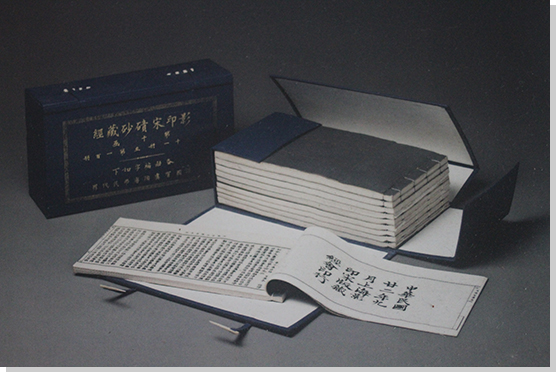Taoyuan has abundant variations of religious resource and multiple options for religious belief, including six of which that are listed in the “100 Religious Attractions in Taiwan” by Ministry of the Interior:
The texts and figures are extracted from the Taiwanese Religious Map- 100 Religious Attractions in Taiwan: https://www.taiwangods.com/html/landscape/1_001.aspx
3.Daxi Zhai-ming Monastery- The only temple that preserves the copy of “Chinese Buddhist Canon” from the Song Dynasty
Landscape Feature:
Daxi Zhai-ming Monastery is originated from Long-hua school from the Chinese religions of fasting, for the past 160 years, it has reflected the progress of gradually declined Chinese religions of fasting in Taiwan and its transformation to Buddhism style. There are abundant collections of antiques and cultural relics in the Temple, and among them, the only copy of “Chinese Buddhist Canon” from the Song Dynasty in Taiwan shall be the most precious one, which is viewed as the first to own the Chinese Buddhist Canon in the Buddhism society of Taiwan. On both sides of the Shrine in the Main Hall, the temple logos of Eihei-ji Temple and Soji-ji Temple of Japan can be seen, they were done due to avoid the destruction of the Temple during Japanization movement during Japanese colonization period by acknowledging Eihei-ji Temple of Japan as the religious leader, which are the vivid evidence that witnessed the history era of Taiwan under Japanese ruling.
History:
In the 30th year of Daoguang Emperor of Qing Dynasty (1850), Li, A-jia, the religious worshipper from Daxi, became a monk from the Fa-yu Temple of Mount Putuo in Nanahai, China. He then was initiated into monkhood at the Jie-tsao Hut near Daxi and named the Hut as Fu-fen Temple and worshiped the Guanyin he invited from Nanahai. In the 12th year of Tongzhi Emperor of Qing Dynasty (1873), the Temple Abbot Huang, Pu-se (dates of birth and death unknown) managed to raise funds to reconstruct the Temple with the local gentries, and renamed it “Zhai-ming Hall”, which was affiliated to the Long-hua school from the Chinese religions of fasting (one of the Taiwanese folklore religious beliefs, also known as the Household Buddhism which combined the philosophy of Confucianism, Taoism and part of Buddhism). The both wings and the Main Hall of the Temple were extended in the 1st year of Taisho era of Japanese colonization period (1912), and the Columbarium Pagoda was constructed behind the Temple for people to place and worship the remains of their ancestors. “The sunset and the Pagoda” has become one of the scenery of the 8 scenery and 12 attractions of Daxi. In 1999, Dharma Drum Mountain took the management of the Temple and constructed meditation rooms, dorms and fasting halls. Due to Zhai-ming Monastery is the major temple of Long-hua school and its unique construction style, it has been categorized as the Taoyuan City Government designated historical spot.
Feature Guidance:
A.Layout of Sangheyuan Temple:
Originally, Daxi Zhai-ming Monastery was a sangheyuan temple building with the layout of single entry and double protecting dragons (“C” shape), later it was extended to the formation of single entry and quad protecting dragons, in front of the east and west wings the Japanese light baskets are placed and the one on the right side was placed during the Showa era. The Main Hall adopted the traditional Minnan style with its artistic decorations and pillars structure. The Main Hall and the protecting dragons of both wings formed the layout of sangheyuan which are connected by mortise and tenon that portray the beauty of Chinese wooden buildings.
B.The Wooden Divine Table Illustrating the Story of “Emperor Xuanzong of Tang Traveling to Lunar Guanghan Palace at Night” Made by Huang, Gue-li:
The divine table at the front of the Main Hall is the rare handmade wooden divine table work made by wood sculptor master Huang, Gue-li (1903-1995), the Tble is made out of an overall piece of boxwood three-dimensionally, at the front side the story of “Emperor Xuanzong of Tang Traveling to Lunar Guanghan Palace at Night” is carved for portraying, the figures are well-made and vivid, which is the most valuable antiques in the Temple.

C.The Only Copy of“Chinese Buddhist Canon” from the Song Dynasty in Taiwan:
The full name of “Chinese Buddhist Canon” is “The Tzi-sha Yan-sheng Temple Version of Chinese Buddhist Canon in Song Dynasty” which was completed by Buddhist nun of three generations who organized the donation at extreme cost and spent 91 years to accomplish such great task. The Buddhist Canon is the well-known collection of various Buddhist literature, and it got its title since it was first made at the Tzi-sha Yan-sheng Temple in Soochow, China. The working period of the sculpted version of“Chinese Buddhist Canon” had cross the era between Song and Yuan Dynasty and included 1,532 copies, 6,362 volumes of Buddhist literature. This ancient version of “Chinese Buddhist Canon” used to be printed for 500 sets of collections by the “Association of Copying Chinese Buddhist Canon of Song Dynasty” in Shanghai in 1931. The then Abbot of Zhai-ming Monastery, Jiang, Pu-chien (dates of birth and death unknown) had managed to apply to bring one set of the collection back to Taiwan from China after its publication, and became the pioneer of preserving the Chinese Buddhist Canon in the Buddhism society of Taiwan.
Useful Tips:
The application in advance is required for conducting photography in Daxi Zhai-ming Monastery, the ancient trail near the Monastery would be filled with the flourish of tung blossoms in May of each year, which is the popular attraction spot for tourists to appreciate the flowers.
Information:
Address: No.153, Zhai-ming St., Daxi Dist., Taoyuan City
Geographic Coordination: 121.27453,24.88907
Fee: Free of charge
Open Dates: 24/7 for the whole year for the guidance
Opening Hours: 9:00 A.M. ~ 5:00 P.M.
Management organization: Dharma Drum Mountain Zhai-ming Monastery
Official Website: https://jms.ddm.org.tw/main/index.aspx?chapid=93
E-mail: L120280@ddmf.org.tw
Fee: (03)380-1426 #203~205